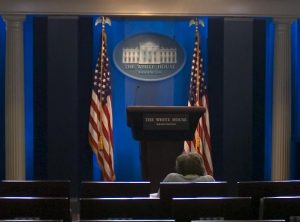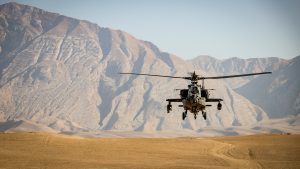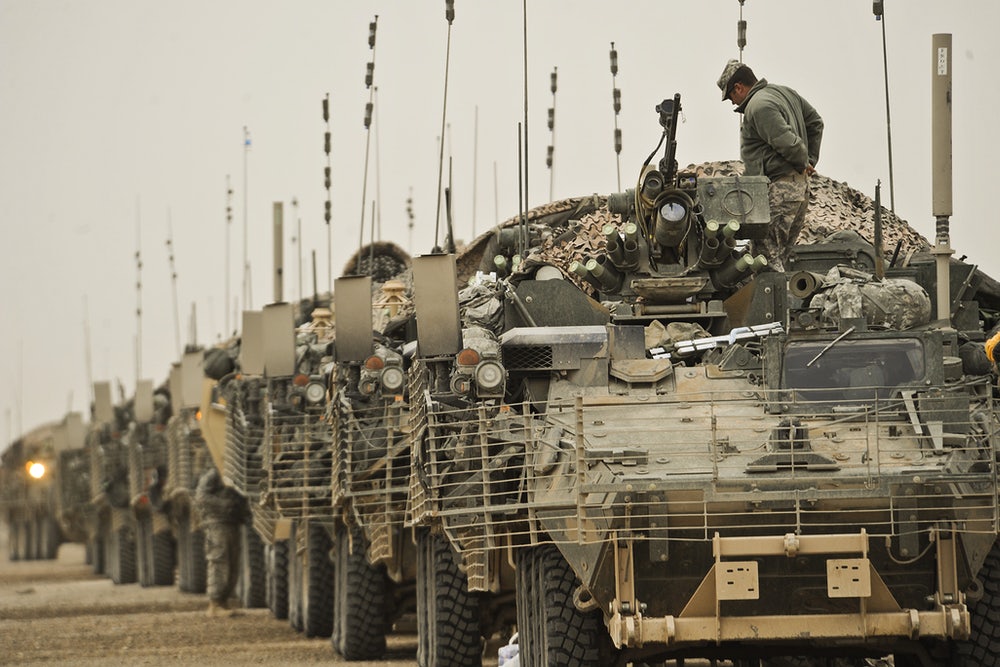News, Sourcing and a Side of Propaganda: Afghanistan and the Vulnerable Free Press

Nestled alongside the shiny white colonnades which divide it from the extravagant Rose Garden; part of the West Wing and connected to the beautiful, pearly white mansion which sits on a bright green lawn maintained seven days a week, 365 days a year; we find ourselves in the small and (as its been described) “musty” White House Briefing Room… Surely an image which juxtaposed greatly to the situation. With decades of context, thousands of soldier and civilian lives lost and a foreign nation wrestling with irreversible trauma and chaos, it was clear that this was the beginning of the end— the culmination of the violence and destruction waged by the United States and its enemies since the September 11th attacks in 2001, and even far longer than that. 1
Simultaneously as thousands of Afghans run alongside fleeing planes at the Hamid Karzai airport2, we find ourselves on August 17, 2021, at the center of the world’s most gracious democracy. It is here where the state meets it’s enemy; the arbiters of freedom, the challengers of power: the press. 3
The previous day, the President had already addressed the nation on the situation, but up to this point there had been no direct communication between the Administration and members of the media. The briefing begins with Jen Psaki, President Joseph Biden’s press secretary, addressing the corps of wide-eyed journalists and correspondents who work in the West Wing, all representing the most significant news organizations and companies in the US, and even the world. Her greeting is brief and sudden, and the already extreme tension is heightened by Psaki’s rush to get off the podium. Immediately she moves to introduce National Security Advisor Jake Sullivan. To say the least, the press was unkind. There was a solid consensus that the method of withdrawal was a failure, and the administration underestimated the ability of the Taliban, who had just seized control of Afghanistan’s capital. Sullivan was inundated with difficult questions from the media corp, where most of his responses fell flat and were hard to defend.4
The White House briefing room is perhaps one of the most important rooms in all of the United States. It is here where Democracy meets its test. Since Nixon, this bustling room, squeezed into the West Wing, has been where the President and the agencies he oversees are held to account.
Ideally, in a perfect Democracy, the press has the ability to challenge information put out by the State. On the surface, it’s very easy to assume that this is exactly what we have, and the briefing room represents just that; a place to hold the powerful accountable. Unlike that of other, more autocratic societies, the expectation is that a “free press” in democratic societies should facilitate a culture of truth; a culture that demands the powerful remain honest or face flack. However, one could argue that what happens in the White House Briefing Room can only mean so much. I highlight it because the function of the press, while not always being perfect, lives up to its ability most notably during these briefing sessions. But the truth is, only so many people pay attention to them, and the real source of many Americans’ news primarily comes from a much more vulnerable place: cable news.
Cable news is not what it used to be, as in it’s largely lost much of it’s live ratings in the age of the internet. In fact, eight of every ten Americans get their news from digital sources5, including online publications like the New York Times and Washington Times, but half of the US population get their news primarily from social media6. Many critics of cable news revel in the idea that Americans are turning away from the TV, but an honest person would have a hard time arguing these news companies aren’t influential. Just from Americans who say they gather their news from YouTube, 49% of the content they consume is from established news organizations. 42% is from independent media7. Tubular Labs, a company based in California who analysis and researches trends in media, found that CNN and Fox News still rank in the top ten of the largest news organizations in the online space. So while CNN ratings are dropping on TV, averaging less than a million viewers during prime time, they are booming on digital platforms with CNN raking in 477M views in a single month, on a single platform. Across all the platforms that CNN runs, Tubular found that this number spikes up to over a billion views, and thousands of different videos8.
But there is an issue here which is often overlooked, and has arguably undermined the ability of the free press to serve its function; holding the powerful accountable. Cable news is incredibly vulnerable to platforming dangerous narratives which serve the purpose of pushing propaganda convenient for corporate and even government interests.
Let’s examine the dangers to democracy posed by strained media; strained as in desperate for sourcing but burdened with a lack of resources. Specifically, focusing on cable news, as it the most at risk of platforming propaganda, information which is convenient to powerful institutions, including the US government and corporations. Using the recent withdrawal, research shows the corporate news media lifted the voices of individuals with interests in the military industrial complex. The vulnerability of “sourcing,” the way the media gathers insight, data analysis or first hand account from experts and professionals keen on a situation impacts the story. The press are threatened by a culture reliant on sourcing from government and potent figures. The public may not easily understand the external influences the press uses to shape their narratives.

First it is important to set context. What did the news used to look like? Well, believe it or not, there was once a time when news organizations represented the interests of the people, and while not perfect, were far less vulnerable than media today. Largely, the early 20th Century represented an era where the news media worked against the most powerful individuals of the time. The Progressive Era was a moment in which news publications, propelled by the penny press, sought to expose the massive inequalities which plagued society. Muckraking and crusading were integral to exposing corruption at the government and corporate levels. With an incredible selection of journalism which represented a massive range of political ideology and stances, and with publications with niche focuses, this era of news represented the most diverse ideal of what a free press should look like. The massive plethora of publications ensured honestly and tranquility, and allowed moments all over the world to be covered with detail with first hand accounts from people and parties all over the spectrum. It was in this time that figures like Joseph Pulitzer founded and headed news organizations which championed worker unions, and progressive policies to improve the lives of the struggling working class people. The Gilded Age is often talked about when discussing inequality and poverty, but arguably a positive output of the Gilded days was that the media served as a friend to the common man.9
But the following century would prove that this ideal press could only last so long. When the radio first came out, licenses from the government were only given to a few companies, essentially creating the conditions for monopolies to form.9 By the time the TV broadcasting became popular, CBS, NBC and ABC were able to secure licenses and dominate the TV space as well. These companies, because of their immense size, were able to eat up the news industry; foreshadowing a bleak future of media consolidation. Even then, encompassing all of news outside of broadcasting, Business Insider11 reports that in 1983, 90% of media was owned by 50 companies. Today, that number sits at just six. Yes, 90% of your American news is owned by just six companies. And this is where the issues begin, because every one of these companies, including Disney, GE, Viacom, CBS, Time Warner and New Corp are all publicly traded companies; and it wouldn’t be far fetched to say that the profit motive supersedes truth12. As is the case of every company which depends on their performance in the stock market, profit is everything.
Now get ready for this transition: just as the news media depends on profit to succeed, so do private weapon manufactures and security intelligence companies.
Coined by President Dwight Eisenhower, the “military industrial complex13” (MIC) refers to the dependent relationship that private weapon manufacturers and security groups have on our military to remain profitable. The MIC suggests that industries of war benefit directly from US military action, and actively engages in lobbying and marketing to ensure peace is rare, and war is perpetual. Part of that system suggests that those private industries depend on the media to propel the popularity of going to war, in what’s been dubbed the “military-media industrial complex.”
When one argues that the MIC depends directly on the media, they are not suggesting conspiracy. No, in fact when looking the recent Afghan withdrawal, it was quite the opposite of what you’d expect if conspiracy were the case. Prominent pundits didn’t align with the MIC. Overwhelmingly, commentators backed the withdrawal, but had quarrels with the strategy that President Biden had used4. No, to suggest that any governmental body depends on the media to push their interests is just an acknowledgement of a culture prevalent in the news, specifically cable, where, despite being part of a “free press,” those who deliver us commentary and news have become reliant on bureaucrats, and interest groups to relay to us, the public, information about the goings on domestically and abroad. In one simple example, you can look at the coronavirus pandemic. From the very beginning, there has been a reliance on the press to extrapolate the latest on Coronavirus and vaccines updates from government officials. Even though much of the information which has been passed on by the CDC has been corroborated by third party, non-government affiliated sources, it is undeniable that there is still a heavy dependence on gathering “expert opinion” from those like Dr. Anthony Fauci, and the CDC newsroom15.
While not all government related opinions are harmful, in fact most are well meaning, we must question what this kind of sourcing entails? What does this reliance on government and powerful individuals suggest about the US having a “free” press? It is likely that we have become so accustomed to government and corporate figures being used as sources that we don’t even think much of it. But we should ask, if our media is heavily dependent on those who they are meant to hold accountable, how can the press possibly act as a check on these institutions and individuals? This kind of sourcing isn’t insidious, but is most likely a direct result of what news consolidation and the profit motive does to cable news coverage. When 24/7 coverage demands quick and easy coverage of a situation, there is only so much that can be said regarding a situation, especially when an event is still developing and information is scarce. Dr. Noam Chomsky, renowned linguist, and famous class-focused activist, details in his book, Manufacturing Consent: The Political Economy of Mass Media16 the “propaganda model,” a theoretical system used by the Powerful to sway the press in their favor, specifically in democratic societies. One of the biggest barriers to a functioning free press is the “sourcing” used by mass media giants. Chomsky describes a “symbiotic relationship” between the press, the government and corporations respectively. As news media has consolidated, and information has been monopolized into the hands of a relative few, the ability of news companies to gather information has become much harder. Simply, not enough resources are available to allow journalists and reporters to be on the scene of every war, every catastrophe, and every event. To meet the strict schedule imposed by the typical media model of consistent, quickly-ready information, sources often head straight to the primary source. When it comes to war and foreign policy, the primary sources are the military generals, diplomats, and bureaucrats who likely have useful knowledge or insight. In the case of Afghanistan, we saw this pattern play out with the rush to interview former military generals and knowledgeable “experts” to give insight on the situation.
Following the collapse of the Afghan government and subsequent take over by the Taliban just eleven days after US forces completed their withdrawal, cable news was inundated with “expert opinions” of those directly tied to the military establishment17. To any viewer, these opinions hold great value. However, what was worryingly not mentioned is that these former military officials held a great financial interest in a prolonged US presence in Afghanistan. As the US military had been pushed to the fringes, essentially holding power of just the Hamid Karzai airport, Richard Haass appeared on The 11th Hour with Brian Williams18. Introduced as a “veteran diplomat under multiple presidents,” and “longtime president of the Council on Foreign Relations,” a reasonable consumer of late night NBC punditry would assume Haas would have more legitimacy when speaking the topic than most others. Haas makes it known, he is a proponent of the Afghan war, and critic of the decision to withdraw. In his interview, he even asked point blank, “… why the policy?” Haas called upon every boogie man that an NBC viewer would quiver at the mention of; asking why would President Biden move forward with a withdrawal that President Trump had negotiated, and why would he leave Afghanistan in a fragile state where China or Russia could easily gain influence?
Similarly, David Patreas, introduced as a former CIA Director, spoke with Lester Holt on August 16, 202119. Patreas blatantly advocated for a prolonged presence in Afghanistan, arguing that success would’ve been possible with “[a lot of] troops,” and “a lot of drones.” However, simple research would show that both of these men have a financial stake in the war. As the Intercept pointed out, Haas sits on the board of Lizard, an investment company with heavy investments in industries such as “aerospace and defense,” even noted right on Lizard’s website. Richard Haas also has ties to Palantir, “a leading tech firm in the defense intelligence space.” As for Patreas, he serves as a board member at Optiv Security, a contractor working with the Department of Defense, which provides cyber security related services. Patreas currently works as a partner for KKR, a private equity firm with heavy investments in defense related industries including the manufacturing of weapons. Both men, although having undeniable extensive knowledge on the situation, used airtime to unabashedly promote their business. What’s worse is that throughout the entirety of both interviews, the fact that both men had a monetary interest was never mentioned whatsoever. Their credentials were misrepresented to exclude their ties to the military industrial complex. After watching the Lester Holt interview, it’s hard to not feel like you just engaged with a desperate salesman trying to sell you endless war. Eventually beyond NBC, these men would make their rounds across several cable news stations including Fox and CNN, where they would make the same case and be given the same insufficient context overlooking their ties to the MIC.
Richard Haas and David Patreas are not anomalies20. Across the cable news coverage of Afghanistan, whether it was “left” or “right” leaning, multiple “experts” made their rounds declaring a similar proposition: the United States should’ve remained in Afghanistan.
The money to be made from participating in the Afghan war was not small, and it’s no wonder those with financial ties to the war have such a heavy interest in ensuring it went on far longer than 20 years. Over those 20 years, the war in Afghanistan cost the American people over $2.3 trillion, as of September 1st, 2021 according to USA Today21. Much of the spending is detailed right on the department of defense’s own website, where as Salon.com noted, 723.91 million had already been allocated to defense contractors for Afghanistan related spending since the beginning of the year, up to August 22nd22.
I’m going to circle-back to a term I had briefly mentioned earlier: the military-industrial-media complex (MIMC). Coined by Fairness and Accuracy in Reporting organization, or FAIR, the MIMC refers to the way the military-industrial complex “manipulates” the media. Just as Lazard, Palantir and KKR were represented by former CIA Director, David Patreas, the MIMC refers to the tendency of private military contractors and investment companies to use credible military personnel to represent their companies in the media. This creates a sense of legitmacy which they otherwise wouldn’t have. In a perfect world, we can rely on noble men and women to tell us what they honestly believe. However, when those individuals are tied to money which begs the continuation of a war which has cost the lives of thousands of soldier and civilian lives, Democracy quivers. A free press is not functional when it platforms money over truth, and this is a direct result of the structural limitations of consolidated and strained media.

To say the least, there is an incredible buck to be made off endless war. Which is why it’s so important to discuss the most major vulnerability of the media: the profit motive. Perhaps the most unfortunate piece of truth defenders of the modern press refuse to believe, is that profit supersede all else. Especially when most news media corporations are owned by far larger, publicly traded companies looking to appease their investors23. For in a system which thrives off viewership, ad revenue, and viewer retention, truth is not the priority. Even when truth is taken into account, the story must be skewed or exaggerated to ensure audiences stay hooked. For when resources are scarce, and time and money are already fleeting, the content of a story becomes less important, and your eyes on staying on your screen become the focus of the network. And with more restraints, the media turns to those already clamoring to get on air; oftentimes being those with an interest to push. Propaganda for the powerful prevails, and truth is sidelined. As with the case of Afghanistan, the media relied on financially vested individuals to give “expert opinion,” essentially disguising propaganda as valuable insight and news. Of course, this has happened before. Outside of corporate backed propaganda during Afghanistan, there’s been time when the Administration and contractors were aligned. The Iraq War was sold to the American people in the same way. In an New York Times article from 2008, titled Behind TV Analysts, Pentagon’s Hidden Hand24, it is detailed how retired pentagon personnel made their rounds on cable news to sell the effectiveness of the Iraq War on President Bush Jr’s behalf. This came at a time when Bush was incredibly unpopular, and the war was seen as a massive failure. The same phenomenon, different year. Their reporting uncovered how many of the personnel giving interviews on cable news networks had ties to military contractors, serving on boards, acting as consultants, working as lobbyists, or active executive members. These powerful men’s “business relationships,” were “hardly ever disclosed to the viewers, and sometimes not even to the networks themselves.”
In an ideal Democracy, the previously labeled, “arbiters of freedom,” should be unbound from the influence of propaganda, whether corporate or government backed. The truth is, there is no perfect system which can facilitate a truly “free press,” but if there’s one thing for sure, consolidation, the profit motive, and strained media harms the sanctity of truth in the news. Cable news specifically is a powerful and influential hub of content, but it is also the most vulnerable. It’s 24/7, year round coverage system-of-operation leaves it strained and desperate for sourcing; leaving it open to the influence of powerful people looking to push their own, financial, interests.
- Connah, Leoni. “US Intervention in Afghanistan: Justifying the Unjustifiable?” South Asia Research 41, no. 1 (February 1, 2021): 70–86. https://doi.org/10.1177/0262728020964609. ↵
- Zucchino, David. “The U.S. War in Afghanistan: How It Started, and How It Ended.” The New York Times. The New York Times, April 22, 2021. https://www.nytimes.com/article/afghanistan-war-us.html. ↵
- Psaki, Jen, and Jake Sullivan. “White House Hold Press Briefing: August 17.” YouTube. NBC News, August 17, 2021. https://www.youtube.com/watch?v=CV-17AP7FlY. ↵
- Dawn.com. “‘Utterly Disastrous Cut-and-Run’: What the US Media Has to Say about Biden’s Withdrawal from Afghanistan.” DAWN.COM, August 16, 2021. https://www.dawn.com/news/1640806. ↵
- Shearer, Elisa. “86% Of Americans Get News Online from Smartphone, Computer or Tablet.” Pew Research Center. Pew Research Center, January 12, 2021. https://www.pewresearch.org/fact-tank/2021/01/12/more-than-eight-in-ten-americans-get-news-from-digital-devices/. ↵
- Walker, Mason, and Katerina Eva Matsa. “News Consumption across Social Media in 2021.” Pew Research Center’s Journalism Project. Pew Research Center, September 20, 2021. https://www.pewresearch.org/journalism/2021/09/20/news-consumption-across-social-media-in-2021/. ↵
- Stocking, Galen, Patrick van Kessel, Michael Barthel, Katerina Eva Matsa, and Maya Khuzam. “Many Americans Get News on YouTube, Where News Organizations and Independent Producers Thrive Side by Side.” Pew Research Center’s Journalism Project. Pew Research Center, November 12, 2020. https://www.pewresearch.org/journalism/2020/09/28/many-americans-get-news-on-youtube-where-news-organizations-and-independent-producers-thrive-side-by-side/#fn-83033-1. ↵
- Jarboe, Greg, About the Author Greg Jarboe Greg Jarboe is President and Co-Founder of SEO-PR, and Greg Jarboe is President and Co-Founder of SEO-PR. “CNN: Billions of Online Video Views Means It’s More than Just a Cable News Network.” Tubular Insights, December 31, 2018. https://tubularinsights.com/cnn-billions-online-video-views/. ↵
- Kovarik, Bill. Revolutions in Communication: Media History from Gutenberg to the Digital Age. New York: Bloomsbury Academic, 2019. ↵
- Kovarik, Bill. Revolutions in Communication: Media History from Gutenberg to the Digital Age. New York: Bloomsbury Academic, 2019. ↵
- Lutz, Ashley. “These 6 Corporations Control 90% of the Media in America.” Business Insider. Business Insider, June 14, 2012. https://www.businessinsider.com/these-6-corporations-control-90-of-the-media-in-america-2012-6. ↵
- “Opinion | All Mainstream Media Networks Serve the Same Goal — Make Tons of Money – The Pitt News.” Accessed September 26, 2021. https://pittnews.com/article/164807/opinions/opinion-all-mainstream-media-networks-serve-the-same-goal-make-tons-of-money/. ↵
- Dunlap, Charles J. “The Military-Industrial Complex.” Daedalus 140, no. 3 (2011): 135–47. http://www.jstor.org/stable/23047354. ↵
- Dawn.com. “‘Utterly Disastrous Cut-and-Run’: What the US Media Has to Say about Biden’s Withdrawal from Afghanistan.” DAWN.COM, August 16, 2021. https://www.dawn.com/news/1640806. ↵
- “Public Trust in FDA and CDC.” Accessed November 8, 2021. https://cdn.annenbergpublicpolicycenter.org/wp-content/uploads/2021/07/APPC_Apppendix_COVID_survey2_0721.pdf. ↵
- Chomsky, Noam, and Herman Herman. Manufacturing Consent, The Political Economy of Mass Media. New York: Pantheon Books, 1988. https://ia802700.us.archive.org/31/items/pdfy-NekqfnoWIEuYgdZl/Manufacturing%20Consent%20%5BThe%20Political%20Economy%20Of%20The%20Mass%20Media%5D.pdf. ↵
- Pha, Anna. “Afghanistan: What’s Next?” Guardian (Sydney), no. 1979 (2021): 8–9. https://search.informit.org/doi/10.3316/INFORMIT.076072754083548. ↵
- Grim, Ryan, Sara Sirota, Lee Fang, and Rose Adams. 2021. “Cable News Military Experts Are on the Defense Industry Dole.” The Intercept. August 19, 2021. https://theintercept.com/2021/08/19/afghanistan-taliban-defense-industry-media/. ↵
- “Extended Interview: Gen. Petraeus on Afghanistan | Nightly …” Accessed November 8, 2021. https://www.youtube.com/watch?v=X54DUH-aM-Y. ↵
- “Full Disclosure: News Pundits’ Hidden Arms … – Youtube.com.” Accessed November 8, 2021. https://www.youtube.com/watch?v=RVKYceDLA2c. ↵
- Stebbins, Samuel. 2019. “Military Spending: 20 Companies Profiting the Most from War.” USA TODAY. WLST. February 21, 2019. https://www.usatoday.com/story/money/2019/02/21/military-spending-defense-contractors-profiting-from-war-weapons-sales/39092315/. ↵
- Sachdev, Shaan. “The War in Afghanistan Was a Huge Victory – for the Military-Industrial Complex.” Salon. Salon.com, August 22, 2021. https://www.salon.com/2021/08/22/the-war-afghanistan-was-a-huge-victory–for-the-military-industrial-complex/. ↵
- Wellstone, Paul. “Growing Media Consolidation Must Be Examined to Preserve Our Democracy.” Federal Communications Law Journal 52 (2000 1999): 551. ↵
- Barstow, David. “Behind TV Analysts, Pentagon’s Hidden Hand.” The New York Times. The New York Times, April 20, 2008. https://www.nytimes.com/2008/04/20/us/20generals.html. ↵



11 comments
Daniel Diaz
The problem with any and all media is that everything must fit a narrative or none of it makes sense. It’s like watching a movie without a plot…sort of like transformers, the idea is so simple: “aliens must fight their enemies on an alien planet” yet it still takes two hours for us to get the message. Finding new ways to deliver the message in a more accurate approach would be the next step to fix the broken system.
Roberto Soriano
This is a really detailed article, it shows you have made your research and that you are very passionate about this article, hopefully one day you can look back on this article and think about how the world has changed from that day. Other than that I like how opinion is stated in this article and how media in the present time is losing credibility. This is not only an issue in the US but worldwide as an International student myself I have seen it in my country for example.
Sophia Kussel
This article expertly points out that propaganda is not just a thing of the past, but is present in our modern era and is very present in our media.
Christian Guerrero
This article was filled with intriguing detail of the press but I never knew the other side of how the press operates. Of course everyone needs to make money but when do we draw the line when it has to do with news and information? After reading this article I can now understand that the press is driven by money as they need to produce interesting stories that the people would read in any means necessary in which could lead to the twisting of stories to make more money. I guess it really is true to say that the world really does run on money sadly.
Camryn Blackmon
Overall this was a fascinating and detailed article. I really enjoyed the attention to detail and how descriptive certain parts of the article were, such as the introduction. The introduction really hooks readers in. I didn’t realize that news media was heavily concerned with money, but it honestly makes sense and is important to talk more about it.
Jaedean Leija
It is no surprise that the media or press doesn’t[‘t give the full story. the more readers that take interest in articles or new reports based off the title the more money the company or press make. I don’t think that is fair because the press is only going to give the people what they want rather than giving the full truth of the story. People will do anything for money and I feel like if this war were to continue then at the point it is all because of money they don’t care who died and who is suffer they just care about the money.
Courtney Pena
This was a very informative article. I agree with you when you mentioned that when the truth is told, the story is always exaggerated so that the audience members can stay hooked. I also think it is crazy how 90% of our news is owned by 6 companies and Disney is one of them.
Hannah Young
Learning all this new information just reminds me of how messed up our systems of communication are in this world today and how much problems can come from the media. I loved reading this article and getting to dive deeper into some forms of corruption that goes on but also makes me feel sick to know that I just read about true events occurring now. Very thought provoking.
Christopher Metta Bexar
For the most part I have to agree with Trenton Boudreaux. As the article says the media is controlled by six huge firms, three of which are movie studios, and one basically a holding company for several different products ( General Electric who is the current owner of NBC). The press has gotten to where money is what matters not jounalism , just like politics is almost more about the careers of professional legislators and not the will of the people.
Rafael Macedo
I find concerning how the press’s corruption has shaped our current thinking. Though this isn’t a new problem, it’s alarming how dependant the media has gotten on money. The majority of the communication vehicles are losing credibility. It’s just unfortunate because in the near future they tend to be insignificant.